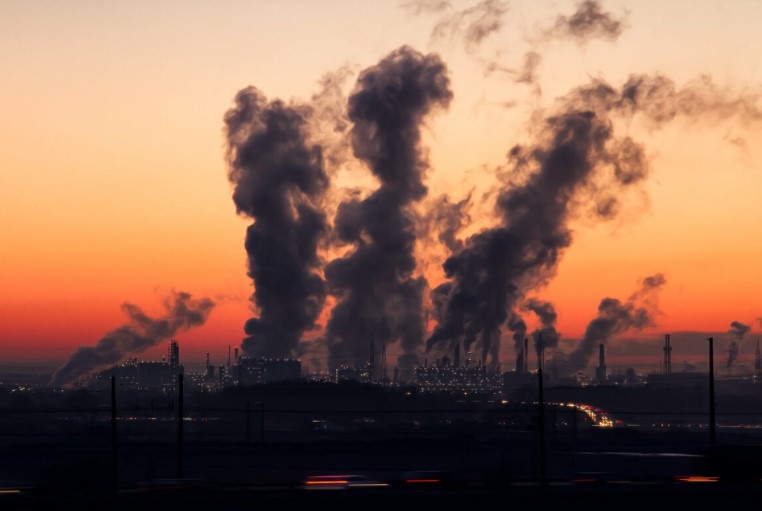Ambient and Emission Air Quality Standard Solution, in this article will not focus more on the discussion of air quality.
Control of air pollution by the government, especially the Ministry of Environment and Forestry of the Republic of Indonesia, said that the air layer up to the troposphere is the jurisdiction of the Republic of Indonesia which can affect human health.
So that harmful air elements such as Carbon monoxide (CO), Nitrogen dioxide (NO2), Sulfurdioxide (SO2), Hydrocarbons (HC), and others must be controlled using air and ambient air emission monitoring technology solutions.
What are Emissions and Ambient?
Air is divided into two, namely emission air and ambient air. Emission air is air released by emission sources such as industrial chimneys, motor vehicle exhausts, or fuel-powered power plants.
Ambient air is free air on the earth’s surface that is used daily by living things such as humans, animals and plants.
What is Ambient Air Quality Standard?
To get good quality ambient air, it is necessary to control air pollution by setting ambient air quality standards.
Ambient air quality standards can be interpreted as the maximum limit of air pollution that is allowed in the air.
There are 13 parameters regulated in ambient air quality standards in the Republic of Indonesia, namely SO2 (Sulfur Dioxide), CO (Carbon Monoxide), NO2 (Nitrogen Dioxide), O3 (Oxide), HC (Hydrocarbons), PM10 and PM2,5 (Particles). , TSP (Dust), Pb (Lead), Dustfall (Dust Fall), Total Fluorides, Fluorine Index, Chlorine and Chlorine Dioxide, and Sulphate Index. More details as follows:
What is Emission Quality Standard?
According to the Regulation of the Minister of Environment and Forestry of the Republic of Indonesia Number P.19/Menlhk/Setjen/Num.1/2/2017 which regulates the emission quality standards for businesses and, or cement industry activities, emission quality standards are the size limit or maximum level or maximum emission load that can be allowed into the ambient air.
What are Air Emissions?
The definition of air emissions is air pollutants resulting from human activities that enter the air, whether they have or do not have the potential for air pollution. So that air emissions are not always something that can pollute the air.
Example of Emission Air Quality Standard
The following picture is an example of an air quality standard where the emission of SO2 in an area exceeds 900 ug/Nm³ per hour, it has exceeded the air threshold determined by the government, therefore an air emission monitoring device is needed.
Air Pollution Standards/ Thresholds
Based on the Government Regulation of the Republic of Indonesia Number 41 of 1999 concerning Air Pollution Control issued May 26, 1999, the following are the National Ambient Air Quality Standards:
1. SO2 (Sulfur Dioxide)
The air pollutant threshold for SO2 is 900 ug/Nm per hour, 365 ug/Nm per 24 hours, and 60 ug/Nm per year. The levels were measured using the pararosanil in analysis method and using a spectrophotometer.
2. CO (Carbon Monoxide)
The threshold for CO pollution is 30,000 ug/Nm per hour, and 10,000 ug/Nm³ per 24 hours. Analyzed using NDIR using the NDIR Analyzer tool.
3. NO2 (Nitrogen Dioxide)
The maximum NO2 air pollutant threshold is 400 ug/Nm per hour, 150 ug/Nm per 24 hours and 100 ug/Nm per year. This NO2 air pollution was analyzed or measured using the Saltzman method with a spectrophotometer.
4. O³ (Oxidant)
The air is said to be O polluted if the levels of these substances exceed the limits of 235 ug/Nm per hour and 50 g/Nm³ per year. Air pollution due to oxidants was analyzed using the Chemilumi nescent method with a spectrophotometer.
5. HC (Hydro Carbon)
The maximum limit or threshold for HC air pollutants is 160 ug/Nm³ per three hours. Analyzed using the Flame Ionization method with a Gas Chromatograph.
6. 10µ Particles and 2.5µ . Particles
The maximum limit of air pollution due to this harmful dust is 150 ug/Nm³ for 24 hours, measured using the Gravimetric c analysis method using the Hi-Vol tool.
Air Emissions Control and Monitoring Solutions
The need for a healthy environment of course also requires clean air. With solutions for controlling and monitoring air emissions need to be applied, especially in industrial areas.
To apply government air emission monitoring regulations to companies, NetData offers a complete and quality air emission control and monitoring solution.
Conclusion
From the discussion above, we can conclude that air emission monitoring devices are required to be used in industrial areas, especially in factories with high air emissions.
Maybe for companies that are just implementing CEMS technology and innovation, they don’t know how to implement the air monitor.
Therefore, NetData as an IT solution provider can provide complete air emission control and monitoring solutions according to company needs.
Don’t hesitate to contact NetData immediately to ask for more details and the availability of air emission control and monitoring tools.
![]()


